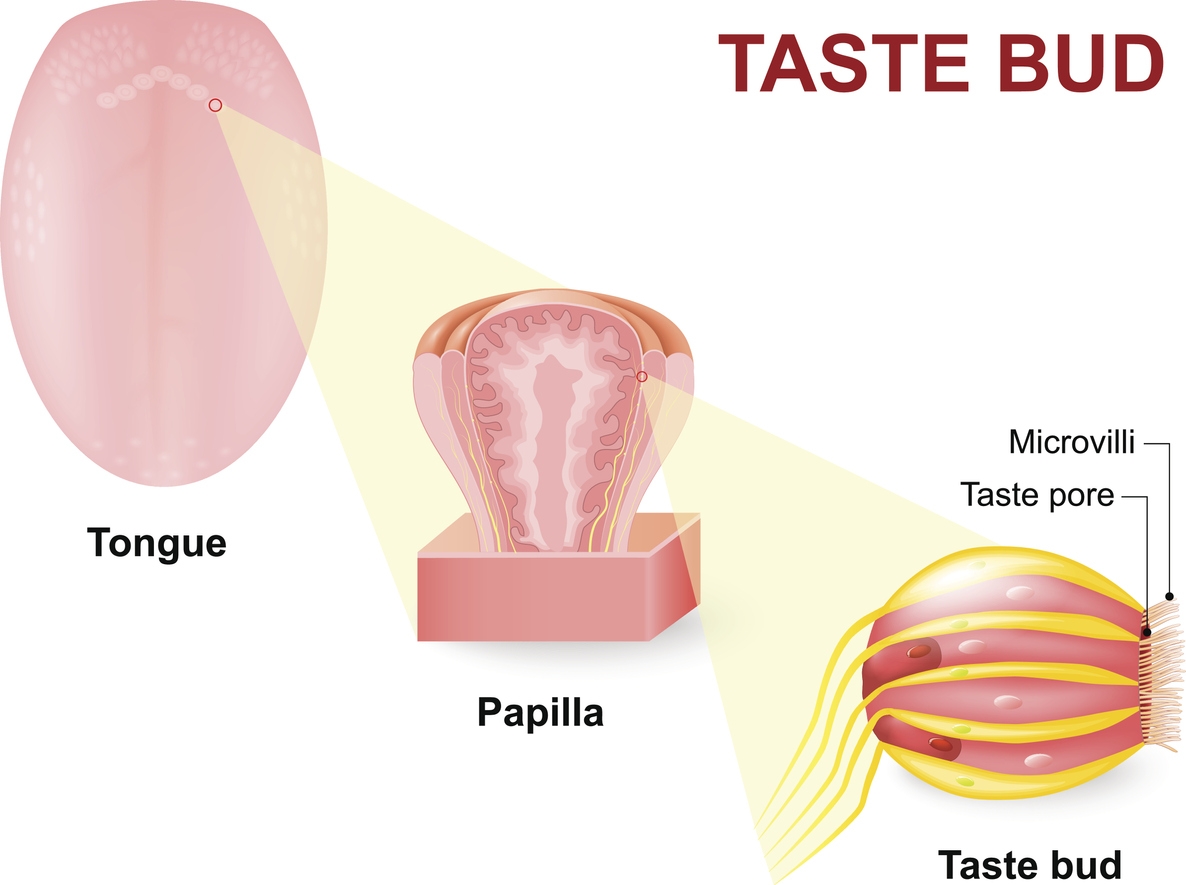Taste is one of those everyday wonders that infuse life with pleasure. It’s the way for us to experience the symphony of flavors in our world from the sweet delight of honey to the sharp tang of a pickle. In simple terms, taste is what makes food, well, tasty. But beyond the deliciousness factor, taste is a big deal. It shapes what we choose to eat, connects us to our cultural roots, and even influences our health.
Understanding the science behind taste is like trying to unravel the mystery behind a magician’s tricks. Get ready to be amazed as we take a deep dive into the world of taste buds and unveil the secrets of how we experience different flavors and the enigma of flavor itself.
Anatomy of the Tongue and Taste Buds
The tongue is a remarkable muscular organ. It’s not just a simple slab of flesh but a complex structure designed for the intricate task of taste perception.
Structure of the Tongue
The surface of the tongue is covered with tiny, specialized structures known as taste buds. They are specialized clusters of cells found on the papillae. [1] Each taste bud contains several types of cells, including taste receptor cells, which are responsible for detecting different taste qualities. These receptor cells have hair-like structures called microvilli that extend into the surrounding environment of the mouth.
Distribution and Function of Taste Buds
These taste receptors are not evenly distributed across the tongue. [2] In fact, they’re more concentrated on certain areas, such as the papillae, tiny bumps that give the tongue its texture. The taste buds can detect five primary tastes:
| Taste Receptor | Detected Taste |
| Sweet | Typically sensed on the tip of the tongue. These allow us to perceive sugary substances. |
| Sour | Found along the sides of the tongue. They help us detect acidic or tart flavors. |
| Bitter | Located at the back of the tongue
They warn us of potential toxins or spoiled foods. |
| Salty | Distributed across the front and sides of the tongue. These respond to sodium-containing compounds. |
| Umami | Recognized at various tongue locations
These identify savory or meaty flavors. |
Each taste receptor cell specializes in one of these tastes, and the combined input from all these cells provides our brain with the rich tapestry of flavors we experience daily.
The Five Basic Tastes
When it comes to culinary experiences, the appreciation of flavors is intricately tied to the fundamental concept of the five basic tastes: sweet, salty, sour, bitter, and umami. [3] These tastes serve as the building blocks of our sensory perception of food. Let’s delve into each of these tastes, uncovering their origins, roles in gastronomy, and significance in our daily lives.
| Taste | Common Sources |
| Sweet | Fruits (e.g., apples, bananas), Desserts (e.g., cakes, cookies), Sweeteners (e.g., honey, sugar) |
| Salty | Seafood (e.g., fish, shrimp), Processed foods (e.g., chips, pretzels), Dairy products (e.g., cheese) |
| Sour | Citrus fruits (e.g., lemons, oranges), Fermented foods (e.g., yogurt, pickles), Berries (e.g., strawberries, raspberries) |
| Bitter | Dark leafy greens (e.g., kale, spinach), Coffee and tea, Cocoa and dark chocolate |
| Umami (Savory) | Tomatoes, Mushrooms, Soy sauce, Aged cheeses (e.g., Parmesan) |
Sweet: Origin and Significance
The sensation of sweetness is a nearly universal human preference, deeply rooted in our biology. This inclination towards sweetness is primarily associated with the presence of sugars in foods.
Sugar is not just something sweet. It is a readily available source of energy. When we taste something sweet, it signals to our brains, making sweetness a pleasurable and sought-after taste. This inherent attraction to sweet flavors may be a survival mechanism, guiding our ancestors toward calorie-rich foods in their natural environments.
Salty: Role in Flavor and Health Implications
Salty tastes play a pivotal role in enhancing the overall flavor profile of numerous culinary creations. Characterized by the presence of sodium ions, they have the remarkable ability to accentuate and elevate other taste components. This creates a more complex and enjoyable taste experience.
However, exercising moderation in salt consumption is essential as excessive salt intake is associated with health concerns. These include hypertension and cardiovascular issues. Striking a balance between savoring the flavor of salt and maintaining optimal health is a key consideration in our dietary choices.
Sour: Characteristics and Common Sources
Sourness, defined by its characteristic acidity, introduces a refreshing and often tangy element to our palate. This taste sensation is created by the presence of acids in various foods. For example, citric acid found in citrus fruits like lemons and lactic acid in fermented foods like yogurt. These sour notes add a lively and zesty dimension to various dishes and beverages, creating a balance of tastes that is both intriguing and enjoyable.
Bitter: Evolutionary Perspective and Common Sources
The bitter taste sensation, while less universally embraced than other tastes, holds unique significance. Specifically from an evolutionary standpoint. Our aversion to bitterness may have served as a protective mechanism against the consumption of potentially toxic substances commonly found in certain plants.
Despite this aversion, bitterness is not inherently undesirable. It can be found in a variety of healthful foods, including dark leafy greens and cruciferous vegetables like broccoli. Appreciating evolutionary roots of this taste helps us understand its complex role in our taste perception and dietary choices.
Umami (Savory): Discovery and Significance
Umami, a Japanese term meaning “pleasant savory taste,” represents the most recently acknowledged basic taste sensation. [4] It was officially recognized in the early 20th century, adding depth to our understanding of taste perception. Umami is experienced when our taste buds detect the presence of glutamate, an amino acid commonly found in foods such as tomatoes, mushrooms, and aged cheeses.
This taste quality enriches the overall flavor profile of dishes, providing a savory and satisfying element that complements other tastes. Salsa, one of the best dip for tortilla chips, is the perfect example of umami taste.
Genetics and Taste Perception
Genetics exert a notable influence on our perception of taste. They determine the number and functionality of taste receptors on our tongues, leading to differences in taste perception among individuals. Understanding this intricate interplay between genetics and external influences provides a deeper comprehension of our diverse and individualized taste experiences.
Genetic Influence on Taste Sensitivity
Our perception of taste is not solely a matter of personal preference. Genetics also play an important role. [5] For instance, genetic factors can influence our ability to detect bitterness or our inclination towards sweetness. This genetic influence on taste sensitivity sheds light on why individuals within the same family may have differing preferences when it comes to flavors. It is a trait that is deeply ingrained in our individual experiences.
| Genetic Factor | Impact on Taste Sensitivity |
| Taste Receptor Genes | Influence perception of sweet, bitter, etc. |
| Number of Taste Buds | Affects sensitivity to different tastes |
| Genetic Variations | Contributes to individual taste profiles |
| Genetic Factor | Impact on Taste Sensitivity |
These genetic factors influence the number and functionality of taste receptors. This intricate interplay between our genes and taste receptors on the tongue shapes how we perceive and respond to different flavors. As a result, some people are more sensitive to bitter tastes, while others exhibit a heightened sensitivity to sweetness or saltiness.
Variations in Taste Preferences
The diversity in taste preferences is a complex web of factors. While our genes establish a baseline for taste sensitivity, our personal experiences and cultural influences also shape our individual taste preferences. [7]
What we find appealing or unappealing on our plates can be influenced by the foods we were exposed to during childhood, regional culinary traditions, and societal norms. What one person finds irresistibly sweet, another may perceive as overly sugary. These variations in taste preferences create a rich tapestry of culinary diversity, reflecting the dynamic interplay between our genetic predispositions and the environments in which we live.
Neuroscience Behind Taste
Our taste buds, while responsible for detecting the fundamental tastes, are merely the starting point of a remarkable journey. The true magic happens within the confines of our brains, where taste is processed and transformed into the rich tapestry of flavors that define our culinary experiences. It is in this intriguing world of Neuroscience where the sensory perception of flavors unfolds
How the Brain Processes Taste?
The experience of taste is not merely confined to the tongue. It’s a complete sensory journey that involves complex neural processes in the brain. When we consume food, taste receptors on our tongues send signals to the brain. Specifically to the gustatory cortex where taste is processed and recognized. [7]
This intricate neural network deciphers the qualities of sweetness, saltiness, sourness, bitterness, and umami, allowing us to savor and identify different flavors. The brain’s involvement in taste perception highlights the remarkable synergy between our sensory organs and cognitive functions.
Connection Between Taste and Memory
Taste and memory share a profound connection. When we taste familiar flavors, it often triggers vivid memories associated with those tastes. [8] The connection between taste and memory finds its roots in the brain’s limbic system, which plays a pivotal role in memory formation. Certain foods can evoke powerful nostalgia, transporting us back to cherished moments in our past. Understanding the interplay between taste and memory not only enhances our appreciation of food but also underscores the intricate ways our brains link sensory experiences with the tapestry of our lives.
Influence of External Factors on Taste
The complexity of taste extends beyond the confines of our taste buds, embracing external factors that shape our culinary experiences. In this section, we will explore how elements beyond flavor contribute to our perception of taste. From the olfactory intricacies to the interplay of temperature and texture, external factors weave into the fabric of taste, creating a multisensory symphony that enhances our enjoyment of food.
| External Factor | Impact on Taste |
| Smell | Enhances flavor perception through aroma |
| Temperature | Influences taste intensity (e.g., warm vs. cold) |
| Texture | Adds a sensory dimension to taste experience |
Role of Smell in Flavor Perception
Taste is not an isolated sense, it collaborates closely with our sense of smell to create the full spectrum of flavor experiences. When we savor a meal, aromas from the food reach our olfactory receptors, enhancing our perception of taste. [9]
This intricate interplay between taste and smell enhances the complexity of flavors. It allows us to distinguish subtle nuances in foods, like the difference between ripe and unripe fruits.
Impact of Temperature and Texture on Taste
Temperature and texture, seemingly unrelated to taste, wield a profound influence on our sensory experiences. The warmth or chill of a dish can intensify or mute certain flavors, [10] while the crunch or creaminess of textures adds layers to our taste perceptions. [11]
Understanding how temperature and texture interact with taste broadens our appreciation for the subtleties that external factors introduce into the culinary landscape.
Cultural and Psychological Aspects of Taste
Culture and psychology are the two dynamic forces that profoundly shape our gastronomic experiences. Let’s look at how our taste preferences are tied to the rich traditions of diverse cultures and the complexities of our own minds.
Cultural Variations in Taste Preferences
Taste preferences are not solely determined by biology. Culture also plays a role in shaping what we find appealing. Different cultures have distinct culinary traditions, and these traditions influence the tastes and flavors that individuals within those cultures favor. [12] For example, some cultures emphasize spicy and pungent flavors, while others lean towards milder and balanced tastes. The ingredients, cooking methods, and regional influences all contribute to these variations.
| Cultural Aspect | Impact on Taste Preferences |
| Regional Cuisine | Shapes flavor profiles and preferred ingredients |
| Culinary Traditions | Influences cooking methods and spice usage |
| Dietary Practices | Determines emphasis on certain tastes in daily meals |
Recognizing these cultural nuances highlights the rich diversity of global cuisine and how it reflects the unique values and traditions of each culture.
Psychological Factors Influencing Taste Perception
Taste perception isn’t solely influenced by our physical senses. Our psychology also exerts a profound impact. Our emotional state, previous experiences, and even our expectations can alter how we perceive taste. [13]
For instance, the same dish may taste different when we’re feeling joyful compared to when we’re experiencing stress. Moreover, our memories and associations with specific foods can evoke complex emotions that influence our enjoyment of flavors.
| Psychological Factor | Impact on Taste Perception |
| Emotional State | Alters taste perception based on mood |
| Previous Experiences | Shapes taste preferences through memories |
| Expectations and Beliefs | Influences perception of taste based on beliefs |
| Cultural Associations | Connects flavors with cultural and personal meaning |
Understanding the psychological dimensions of taste perception provides insights into the intricate relationship between our minds and our palates, showcasing the dynamic interplay of the psychological factors that shape our culinary encounters.
Conclusion
Taste is a multifaceted experience woven from biology, culture, psychology, and the intricate workings of our sensory systems. From the fundamental influences of our genetic makeup on taste sensitivity to the collaborative dance of taste and smell in flavor perception, each element plays a crucial role.
Besides what’s going around in our body, there are certain external factors, such as temperature and texture, that add more layers to our culinary experiences. Cultural diversity also underscores the varied tastes that shape our global palate, while psychological factors illuminate the complex interplay between emotions and flavor. Together, these aspects converge, creating the rich symphony that defines the profound and fascinating world of taste perception.





